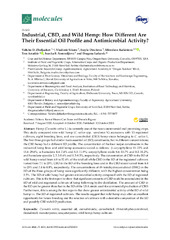Приказ основних података о документу
Industrial, CBD, and Wild Hemp: How Different Are Their Essential Oil Profile and Antimicrobial Activity?
| dc.creator | Zheljazkov, Valtcho D. | |
| dc.creator | Sikora, Vladimir | |
| dc.creator | Dincheva, Ivayla | |
| dc.creator | Kacaniova, Miroslava | |
| dc.creator | Astatkie, Tess | |
| dc.creator | Semerdjieva, Ivanka B. | |
| dc.creator | Latković, Dragana | |
| dc.date.accessioned | 2021-04-26T19:54:50Z | |
| dc.date.available | 2021-04-26T19:54:50Z | |
| dc.date.issued | 2020 | |
| dc.identifier.issn | 1420-3049 | |
| dc.identifier.uri | http://fiver.ifvcns.rs/handle/123456789/2029 | |
| dc.description.abstract | Hemp (Cannabis sativa L.) is currently one of the most controversial and promising crops. This study compared nine wild hemp (C. sativa spp. spontanea V.) accessions with 13 registered cultivars, eight breeding lines, and one cannabidiol (CBD) hemp strain belonging to C. sativa L. The first three groups had similar main essential oil (EO) constituents, but in different concentrations; the CBD hemp had a different EO profile. The concentration of the four major constituents in the industrial hemp lines and wild hemp accessions varied as follows: beta-caryophyllene 11-22% and 15.4-29.6%; alpha-humulene 4.4-7.6% and 5.3-11.9%; caryophyllene oxide 8.6-13.7% and 0.2-31.2%; and humulene epoxide 2, 2.3-5.6% and 1.2-9.5%, respectively. The concentration of CBD in the EO of wild hemp varied from 6.9 to 52.4% of the total oil while CBD in the EO of the registered cultivars varied from 7.1 to 25%; CBD in the EO of the breeding lines and in the CBD strain varied from 6.4 to 25% and 7.4 to 8.8%, respectively. The concentrations of delta 9-tetrahydrocannabinol (THC) in the EO of the three groups of hemp were significantly different, with the highest concentration being 3.5%. The EO of wild hemp had greater antimicrobial activity compared with the EO of registered cultivars. This is the first report to show that significant amounts of CBD could be accumulated in the EO of wild and registered cultivars of hemp following hydro-distillation. The amount of CBD in the EO can be greater than that in the EO of the USA strain used for commercial production of CBD. Furthermore, this is among the first reports that show greater antimicrobial activity of the EO of wild hemp vs. the EO of registered cultivars. The results suggest that wild hemp may offer an excellent opportunity for future breeding and the selection of cultivars with a desirable composition of the EO and possibly CBD-rich EO production. | en |
| dc.publisher | Basel : MDPI | |
| dc.rights | openAccess | |
| dc.source | Molecules | |
| dc.subject | Cannabis sativa | en |
| dc.subject | essential oil | en |
| dc.subject | cannabinoids | en |
| dc.subject | cannabidiol | en |
| dc.subject | 9-tetrahydrocannabinol | en |
| dc.subject | dronabinol | en |
| dc.subject | monoterpenes | en |
| dc.subject | sesquiterpenes | en |
| dc.subject | wild hemp | en |
| dc.subject | hemp cultivars | en |
| dc.title | Industrial, CBD, and Wild Hemp: How Different Are Their Essential Oil Profile and Antimicrobial Activity? | en |
| dc.type | article | |
| dc.rights.license | ARR | |
| dc.citation.issue | 20 | |
| dc.citation.other | 25(20) | |
| dc.citation.rank | M22 | |
| dc.citation.volume | 25 | |
| dc.identifier.doi | 10.3390/molecules25204631 | |
| dc.identifier.fulltext | http://fiver.ifvcns.rs/bitstream/id/957/2026.pdf | |
| dc.identifier.pmid | 33053634 | |
| dc.identifier.scopus | 2-s2.0-85090780449 | |
| dc.identifier.wos | 000585706100001 | |
| dc.type.version | publishedVersion |


